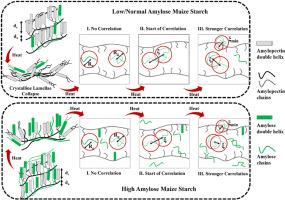不同直链淀粉含量玉米淀粉糊化机理的原位小角x射线散射研究
IF 11
1区 农林科学
Q1 CHEMISTRY, APPLIED
引用次数: 0
摘要
淀粉的糊化行为受到直链淀粉含量(AC)的严重影响,但其在片层水平上的潜在机制尚不完全清楚,特别是对于直链淀粉含量高(50%)的淀粉。在这项研究中,我们利用原位小角x射线散射(SAXS)研究了具有大范围AC(3.2% - 79.6%)的玉米淀粉在糊化过程中的实时结构演变。当从40°C加热到90°C时:(1)板层增厚最初发生,但随后在低AC(3.2%和26.3%)下迅速破坏;(2)在高交流电(58.6%)下,片层结构保持稳定,片层峰强度和片层厚度变化不大;(3)晶体与非晶态之间的电子密度对比增加,两种片层类型在高交流电(71.2%和79.6%)下都表现出增厚。此外,相关长度(ξ)随着AC的增加而减小,最大可达60%,表明由于链的释放和纠缠更大,粘弹性结构更紧密。我们的数据提供的证据表明,玉米淀粉约60%直链淀粉具有特别稳定的结晶片。这种稳定性可能解释了为什么直链淀粉含量较高的淀粉在较高温度下容易糊化。本文章由计算机程序翻译,如有差异,请以英文原文为准。

In Situ small-angle X-ray scattering study of the gelatinization mechanism of maize starches with varying amylose content
The gelatinization behavior of starch is critically influenced by its amylose content (AC), yet the underlying mechanisms at the lamellar level remains incompletely understood, especially for starches with high AC (>50 %). In this study, we investigated the real-time structural evolution of maize starches with a wide range of AC (3.2 %–79.6 %) during gelatinization using in situ small-angle X-ray scattering (SAXS). Upon heating from 40 °C to 90 °C: (1) the lamellar thickening occurred initially but was followed by rapid disruption at low AC (3.2 % and 26.3 %); (2) the lamellar structure remained stable with minimal changes in lamellar peak intensity and lamellar thickness at high AC (58.6 %), (3) the electron density contrast between crystalline and amorphous phases increased, and both lamellar types exhibited thickening at very high AC (71.2 % and 79.6 %). Furthermore, the correlation length (ξ) decreased with increasing AC up to 60 %, suggesting a more compact viscoelastic structure due to greater chain release and entanglement. Our data provide evidence that maize starch with about 60 % amylose has especially stable crystalline lamellae. This stability likely explains why starches with moderately high amylose content tend to gelatinize at higher temperatures.
求助全文
通过发布文献求助,成功后即可免费获取论文全文。
去求助
来源期刊

Food Hydrocolloids
工程技术-食品科技
CiteScore
19.90
自引率
14.00%
发文量
871
审稿时长
37 days
期刊介绍:
Food Hydrocolloids publishes original and innovative research focused on the characterization, functional properties, and applications of hydrocolloid materials used in food products. These hydrocolloids, defined as polysaccharides and proteins of commercial importance, are added to control aspects such as texture, stability, rheology, and sensory properties. The research's primary emphasis should be on the hydrocolloids themselves, with thorough descriptions of their source, nature, and physicochemical characteristics. Manuscripts are expected to clearly outline specific aims and objectives, include a fundamental discussion of research findings at the molecular level, and address the significance of the results. Studies on hydrocolloids in complex formulations should concentrate on their overall properties and mechanisms of action, while simple formulation development studies may not be considered for publication.
The main areas of interest are:
-Chemical and physicochemical characterisation
Thermal properties including glass transitions and conformational changes-
Rheological properties including viscosity, viscoelastic properties and gelation behaviour-
The influence on organoleptic properties-
Interfacial properties including stabilisation of dispersions, emulsions and foams-
Film forming properties with application to edible films and active packaging-
Encapsulation and controlled release of active compounds-
The influence on health including their role as dietary fibre-
Manipulation of hydrocolloid structure and functionality through chemical, biochemical and physical processes-
New hydrocolloids and hydrocolloid sources of commercial potential.
The Journal also publishes Review articles that provide an overview of the latest developments in topics of specific interest to researchers in this field of activity.
 求助内容:
求助内容: 应助结果提醒方式:
应助结果提醒方式:


